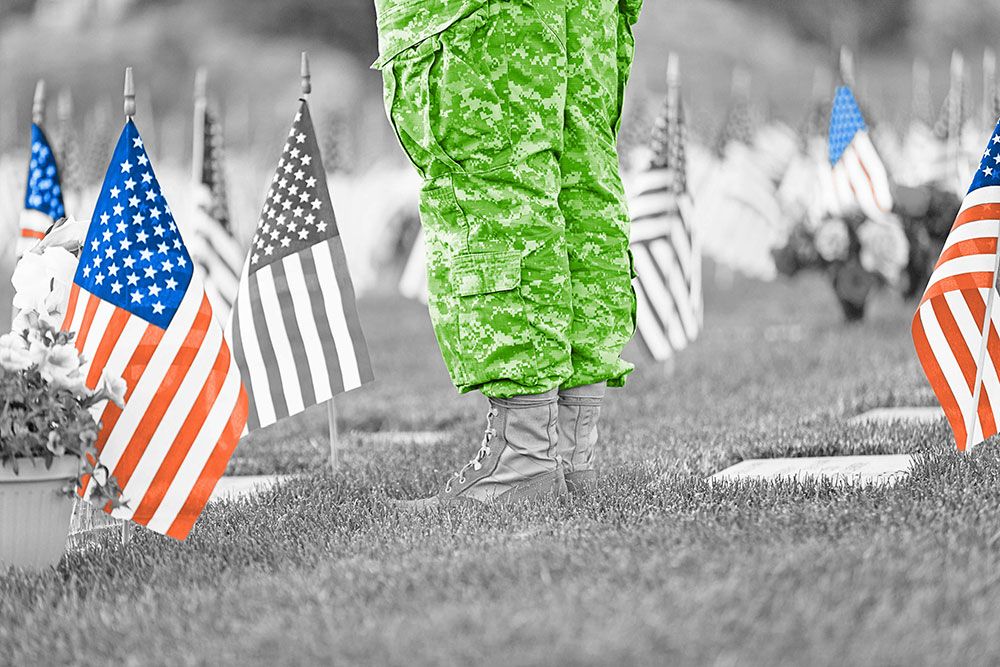

Although many people look forward to Memorial Day as the unofficial start of summer, with pools and beaches opening and shuttered offices offering the chance to get out of town, the promise of a fun-filled weekend can obscure the meaning of a day intended to honor the military servicemen and women who lost their lives in battle. Read on to learn more about Memorial Day’s origins and other facts related to this American-born day of remembrance.
The Holiday Was Originally Known as "Decoration Day"

In the aftermath of the brutally bloody Civil War, communities in both Northern and Southern locales, especially widows, adopted the custom of visiting cemeteries in springtime to place flowers on the graves of fallen soldiers. One early proponent was Mary Ann Williams, a Georgia woman who entreated Southern women to decorate their fallen men’s graves, leading to a Confederate-focused holiday in Southern states that began in 1866. General John A. Logan of the Grand Army of the Republic (GAR) veterans group then worked to popularize the holiday in the North. He declared May 30 as the date for such observances, and in 1868, the first major Decoration Day ceremony was held at Virginia’s Arlington National Cemetery. New York subsequently became the first state to make Decoration Day a legal holiday in 1873, and by 1890, every other former Union state had done the same.
The Town of Waterloo, New York, Is Recognized as the "Birthplace" of Memorial Day

More than two dozen sites have been linked to the foundation of Memorial Day, including a former racetrack in Charleston, South Carolina, that hosted a celebration by freed African Americans less than a month after Robert E. Lee's surrender at Appomattox Court House. However, the formal winner of this designation is the town of Waterloo, New York, which was recognized by President Lyndon B. Johnson for its role as the "birthplace" of Memorial Day in 1966. On May 5, 1866, Waterloo held what has been called the "first, formal, complete, well-planned, village-wide observance of a day entirely dedicated to honoring the war dead."
Memorial Day Became a Federal Holiday in 1971

On June 28, 1968, President Johnson signed into law the Uniform Holiday Bill, which established Memorial Day as one of a series of federal holidays. Additionally, the bill decreed that Memorial Day (along with other holidays like George Washington’s Birthday and Veterans Day) would not take place on a fixed date, but would be observed on a Monday. LBJ was upfront about the economic reasons behind these extended holiday weekends, which he claimed would "stimulate greater industrial and commercial production." However, the associated commercialization continues to rankle plenty of veterans, some of whom want to see Memorial Day returned to its initial date of May 30.
There’s a Special Time of Day to Mark It

In response to the sense that the holiday was devoid of some of its original meaning, Congress in 2000 passed a law designed to prompt more sober observations of Memorial Day. The National Moment of Remembrance Act legally established 3:00 p.m. local time on Memorial Day as a moment to be observed “to raise awareness of and respect for the national heritage, and to encourage citizens to dedicate themselves to the values and principles for which those heroes of the United States died.”
Ever since, the federal government — and even entities such as Greyhound and NASCAR — have observed a moment of silence at that hour. But one company marks it in a much louder way: Amtrak’s train conductors sound a long whistle during the moment of remembrance each year.
Formal Observances Include Guidelines for Flying Flags

Beyond the traditional parades held in many towns and the National Moment of Remembrance at 3 p.m. local time, there are a series of formalities tied to the commemoration of this holiday. Arlington National Cemetery remains the site of an annual ceremony marked by the laying of a wreath at the Tomb of the Unknown Soldier. There's even an established Memorial Day protocol for those responsible for manning a flagpole: The flag is to be flown at half-staff from sunrise until noon, then raised briskly to the top of the staff until sunset.
The Holiday’s Red Poppy Tribute Began After World War I

The wearing of red poppies as a Memorial Day tradition grew from the World War I experiences of Canadian Lieutenant Colonel John McCrae. Noting the proliferation of the flowers on the scarred European battlefields, McCrae penned the short but moving poem "In Flanders Fields," which appeared in London's Punch magazine in late 1915. The poem inspired American professor Moina Michael to campaign for the poppy as a symbol of remembrance, with Frenchwoman Anna Guérin picking up the cause on the other side of the Atlantic. Both clearly found a receptive audience, although outside the United States the remembrance poppies are more commonly associated with Armistice Day (Veterans Day in the U.S.).
An American General Delivered a Memorial Day Speech for the Ages in 1945

Memorial Day has been the occasion of many notable speeches. President Reagan offered a tribute to the remains of an unknown Vietnam combatant in 1984. LBJ foreshadowed the arrival of civil rights legislation in 1963. But perhaps the most stirring oratory was one that was delivered at Italy's Sicily-Rome American Cemetery in 1945 by General Lucian Truscott Jr. According to famed World War II cartoonist Bill Maudlin, the general stunned the audience when he suddenly turned and began addressing the soldiers buried behind him. "It was the most moving gesture I ever saw," Maudlin later wrote in his memoir. "He promised that if in the future he ran into anybody, especially old men, who thought death in battle was glorious, he would straighten them out. He said he thought that was the least he could do."
